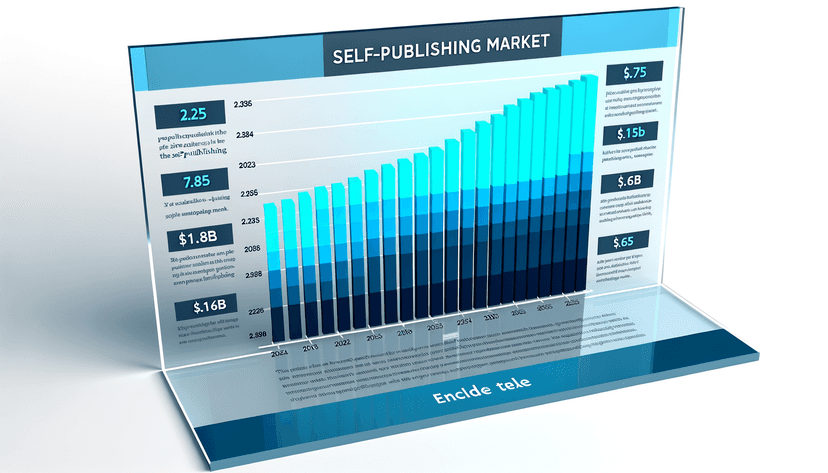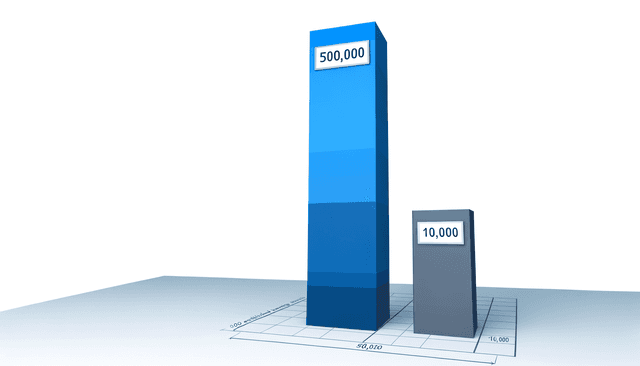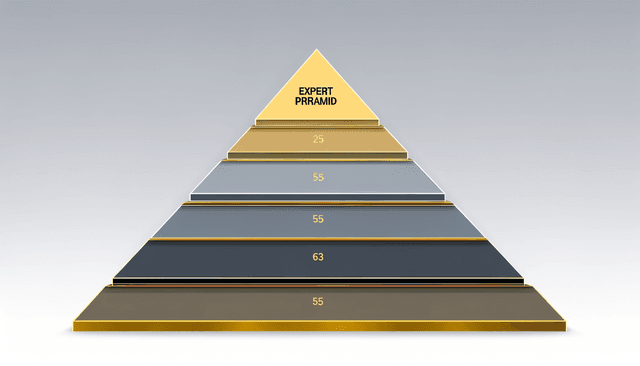Table of Contents
Self-publishing has evolved from a niche alternative to a mainstream force in the publishing world. If you're curious about where the industry stands in 2025, you're in the right place. Let's dive into the fascinating numbers, trends, and opportunities that are shaping the self-publishing landscape today.
From market size projections to author earnings and emerging technologies, we'll explore everything you need to know about self-publishing in 2025. Whether you're an aspiring author, a seasoned indie publisher, or just interested in publishing trends, these statistics will give you valuable insights into this rapidly growing industry.
Self-Publishing Market Size and Growth
The self-publishing industry is experiencing unprecedented growth, and the numbers tell a compelling story about the future of independent publishing.
- $1.85 Billion Market in 2024: The global self-publishing market reached approximately $1.85 billion in 2024, marking a significant milestone in the industry's evolution. This represents a massive shift from traditional publishing dominance to author empowerment.
- 16.7% Annual Growth Rate: The market is projected to grow at a compound annual growth rate (CAGR) of 16.7% from 2025 to 2033. This exceptional growth rate far exceeds traditional publishing, showing that self-publishing isn't just a trend—it's the future.
- $6.16 Billion by 2033: Industry analysts project the self-publishing market will reach $6.16 billion by 2033. That's more than triple the current market size, demonstrating incredible long-term potential for authors and service providers.
- $268.6 Million Self-Publishing Services Market: The self-publishing services market alone (including cover design, editing, formatting, and distribution services) is valued at around $268.6 million in 2025 and is growing at a CAGR of 6.4% through 2033.
Self-Publishing Market Growth Projections
| Year | Market Size (USD) | Growth Rate |
|---|---|---|
| 2024 | $1.85 billion | — |
| 2025 | $2.16 billion | +16.7% |
| 2028 | $3.52 billion | +16.7% CAGR |
| 2033 | $6.16 billion | +16.7% CAGR |
The growth is being driven by several key factors: digital transformation, increasing technological adoption, declining barriers to entry, and evolving author preferences toward independence and creative control.

Self-Published Book Output Exploding
The sheer volume of self-published books has grown exponentially, fundamentally changing the publishing landscape.
- 2.6 Million+ Self-Published Titles in 2023: The number of self-published titles with ISBNs surpassed 2.6 million in 2023, representing a 7.2% increase over 2022. This explosive growth shows no signs of slowing down.
- More Than 2 Million More Than Traditional: Self-published books now outnumber traditionally published titles by more than two million annually. This represents a complete reversal from just a decade ago when traditional publishing dominated.
- Output Doubled in a Decade: The self-publishing sector has more than doubled its output in the past ten years, showcasing the rapid democratization of the publishing industry.
- 500,000 US Self-Published Works in 2023: In the United States alone, approximately 500,000 new self-published works were released in 2023, compared to just 10,000 from traditional publishers. That's a 50:1 ratio!
Self-Published vs Traditional Publishing Output
| Publishing Type | Annual Titles (US, 2023) | Market Share |
|---|---|---|
| Self-Published | 500,000 | 98% |
| Traditional Publishers | 10,000 | 2% |
| Total | 510,000 | 100% |
It's worth noting that much like Amazon's dominance in book sales, platforms like Kindle Direct Publishing have revolutionized how authors bring their work to market. The ease of self-publishing through these platforms has created an entirely new author ecosystem.

Key Self-Publishing Platforms in 2025
Several major platforms are driving the self-publishing revolution, each offering unique advantages to authors.
- Kindle Direct Publishing (KDP): Amazon's KDP remains the dominant platform, accounting for the majority of self-published ebook sales. With over 1.4 million self-published titles released annually through KDP alone, it's the go-to platform for most indie authors.
- Apple Books: Apple's platform has been gaining ground, especially among authors targeting premium readers willing to pay higher prices for quality content. Apple Books offers excellent royalty rates and global distribution.
- Google Play Books: Google's entry into self-publishing provides authors with access to Android users worldwide. While smaller than Amazon, it's a valuable additional revenue stream.
- Kobo Writing Life: Popular internationally, especially in Canada and Europe, Kobo offers competitive royalties and strong support for independent authors.
- IngramSpark: For print distribution to bookstores and libraries, IngramSpark has become essential, offering professional-grade distribution that rivals traditional publishers.
Self-Publishing Platform Comparison
| Platform | Market Share | Primary Strength | Royalty Rate |
|---|---|---|---|
| Kindle Direct Publishing | ~65-70% | Largest ebook marketplace | Up to 70% |
| Apple Books | ~10-12% | Premium audience | 70% |
| Google Play Books | ~5-7% | Android user base | 52-70% |
| Kobo | ~5-8% | International reach | Up to 70% |
| IngramSpark | N/A (Print focus) | Bookstore distribution | Varies |
The accessibility of these platforms has made self-publishing more viable than ever. Just as we've seen with Amazon's impact on overall book sales, these platforms have democratized publishing and given authors unprecedented control over their work.
Author Earnings and Income Reality
Let's talk about the money. Self-publishing offers incredible opportunities, but it's important to understand the income reality.
- $1.25 Billion Annual Sales: The self-published book market sold an estimated 300 million copies annually, generating approximately $1.25 billion in sales. This represents significant revenue flowing directly to authors rather than traditional publishers.
- 300 Million Copies Sold: Self-published books sold around 300 million copies in the US market alone in 2023, demonstrating strong reader demand for indie-published content.
- Average Earnings Reality: While some authors earn six or seven figures, the reality is that approximately 75% of self-published authors earn less than $1,000 per year from their books. Success requires not just writing talent but also marketing savvy and persistence.
- Top Earners Make Millions: The top 1% of self-published authors earn substantial six-figure or even seven-figure incomes annually. These success stories, while rare, demonstrate the platform's potential for those who master both craft and marketing.
Self-Published Author Income Distribution
| Income Range (Annual) | Percentage of Authors |
|---|---|
| Less than $1,000 | ~75% |
| $1,000 - $10,000 | ~18% |
| $10,000 - $50,000 | ~5% |
| $50,000 - $100,000 | ~1.5% |
| $100,000+ | ~0.5% |
It's important to note that these earnings are before expenses. Successful self-published authors invest in professional editing, cover design, marketing, and advertising. However, they retain complete control over pricing and distribution, which can lead to higher per-book royalties than traditional publishing offers.

Technology Driving Self-Publishing Forward
Emerging technologies are revolutionizing self-publishing, making it easier and more accessible than ever before.
- AI-Powered Cover Design: Automated tools now help authors create professional-looking book covers without hiring expensive designers. AI analyzes genre conventions and trends to suggest optimal designs.
- AI Blurb Creation: Artificial intelligence can now generate compelling book descriptions and marketing copy, helping authors who struggle with self-promotion to create effective sales materials.
- Automated Royalty Management: New platforms offer sophisticated royalty tracking across multiple retailers, tax management, and financial reporting, simplifying the business side of self-publishing.
- Print-on-Demand Technology: Advanced POD services mean authors never need to maintain inventory. Books are printed only when ordered, eliminating upfront costs and storage concerns.
- Global Distribution Networks: Digital platforms now offer instant worldwide distribution, allowing authors to reach readers in virtually every country without additional effort or cost.
Technology Adoption in Self-Publishing
| Technology | Adoption Rate | Primary Benefit |
|---|---|---|
| AI Cover Design Tools | 42% | Cost reduction |
| Automated Marketing | 38% | Time savings |
| Print-on-Demand | 87% | No inventory costs |
| Multi-Platform Distribution | 65% | Wider reach |
| Royalty Management Software | 51% | Financial clarity |
These technological advances have lowered the barriers to entry significantly. What once required tens of thousands of dollars in upfront investment can now be done for a few hundred dollars or even less with the right tools and knowledge.
Author Demographics and Preferences
The demographics of self-published authors reveal interesting trends about who is choosing independent publishing and why.
- Younger Authors Prefer Self-Publishing: Authors under 45 are increasingly choosing self-publishing over traditional routes, with many viewing it as their first choice rather than a fallback option. This generational shift is reshaping the industry.
- Direct Reader Relationships: Modern authors are building direct connections with their audiences through newsletters, social media, and personal websites. Over 60% of successful self-published authors maintain email lists with thousands of subscribers.
- Full Creative Control: The #1 reason authors choose self-publishing is complete control over cover design, pricing, distribution, and marketing decisions. This autonomy is valued more highly than the prestige of traditional publishing.
- Faster Time to Market: Self-published authors can go from finished manuscript to published book in weeks rather than the 18-24 months typical of traditional publishing. This speed is especially valuable for trend-based or timely content.
Why Authors Choose Self-Publishing
| Reason | Percentage of Authors |
|---|---|
| Creative control | 78% |
| Higher royalty rates | 72% |
| Faster publication timeline | 68% |
| Keep all rights to work | 65% |
| Direct reader relationship | 61% |
| Flexibility to experiment | 54% |
| No gatekeepers | 49% |
Similar to trends we see in Amazon's book marketplace, self-published authors are increasingly savvy about marketing and audience building. They understand that success requires more than just writing a good book—it requires entrepreneurial thinking and audience engagement.
Direct-to-Reader Sales Revolution
One of the most exciting developments in self-publishing is the growth of direct-to-reader sales, bypassing traditional retailers entirely.
- Higher Author Profits: By selling directly from their own websites, authors can earn 90-95% of the sale price instead of the 35-70% offered by major platforms. This dramatic increase in per-book profit can transform an author's income.
- Email List Power: Authors with large email lists (10,000+ subscribers) often generate 30-50% of their income from direct sales. These lists are built through reader magnets, social media, and consistent reader engagement.
- Subscription Models: Some authors have launched Patreon accounts or subscription services where readers pay monthly for early access to new books, bonus content, or behind-the-scenes material.
- Bundle and Box Set Sales: Direct sales platforms allow authors to create exclusive bundles and box sets not available elsewhere, providing additional value to their most dedicated readers.
Direct Sales vs Platform Sales Comparison
| Sales Channel | Author Revenue % | Reader Data Access | Marketing Control |
|---|---|---|---|
| Direct Website Sales | 90-95% | Full access | Complete |
| Amazon KDP (70%) | 70% | Limited | Moderate |
| Amazon KDP (35%) | 35% | Limited | Moderate |
| Other Retailers | 60-70% | None | Limited |
While platforms like Amazon still represent the majority of sales for most authors, the trend toward direct sales is growing rapidly. Smart authors are building diversified income streams that reduce dependence on any single platform.
Self-Publishing vs Traditional Publishing
How does self-publishing stack up against the traditional route? Let's look at the key differences.
- Speed to Market: Self-published books can be ready for sale in 4-8 weeks, while traditional publishing typically takes 18-24 months from contract to bookstore. For timely content, this speed advantage is crucial.
- Royalty Rates: Traditional publishers typically offer 10-15% royalties on print books and 25% on ebooks. Self-published authors can earn 35-70% on ebooks and similar rates on print, resulting in significantly higher per-book earnings.
- Advance Payments: Traditional publishing offers advance payments (though these are declining and often modest for new authors). Self-publishing requires upfront investment but authors keep all profits.
- Marketing Support: Traditional publishers provide some marketing, but increasingly expect authors to do most promotion themselves. Self-published authors handle all marketing but retain complete control over strategies and budgets.
- Bookstore Placement: Traditional publishing offers better access to physical bookstores, though this matters less as ebook sales grow. Self-published authors can access bookstores through IngramSpark but face more challenges.
Self-Publishing vs Traditional Publishing Breakdown
| Factor | Self-Publishing | Traditional Publishing |
|---|---|---|
| Time to publish | 4-8 weeks | 18-24 months |
| Ebook royalties | 35-70% | 25% |
| Print royalties | 35-60% | 10-15% |
| Upfront costs | $500-5,000 | $0 |
| Advance payment | None | $0-50,000+ (varies widely) |
| Creative control | 100% | Limited |
| Rights retention | 100% | Limited or none |
| Marketing responsibility | 100% author | Mostly author |
The choice between self-publishing and traditional publishing isn't about which is "better"—it's about which aligns with your goals, resources, and strengths as an author. Many successful authors now pursue hybrid approaches, self-publishing some works while pursuing traditional contracts for others.
Future Trends and Predictions
What does the future hold for self-publishing? Several trends are emerging that will shape the industry over the next few years.
- AI Integration Will Accelerate: Artificial intelligence will become increasingly integrated into every aspect of self-publishing, from writing assistance to marketing automation. Authors who embrace these tools will have significant competitive advantages.
- Audio Growth Continues: Audiobook consumption continues growing at 20%+ annually. Self-published authors are increasingly producing audio versions, often using AI narration to reduce costs while maintaining quality.
- Subscription Models Expand: More authors will launch direct subscription services, following the success of platforms like Patreon. These recurring revenue models provide income stability that per-book sales cannot match.
- International Markets Open Up: Translation technology improvements will make it easier for authors to reach global markets. The international self-publishing market is expected to grow even faster than the US market.
- Video Content Integration: Authors are increasingly creating video content (BookTok, YouTube) to market their books, with some building audiences of hundreds of thousands before even publishing their first book.
Projected Self-Publishing Trends (2025-2030)
| Trend | Current State | 2030 Projection |
|---|---|---|
| AI tool adoption | 42% | 85% |
| Audiobook availability | 35% | 75% |
| Direct sales percentage | 15% | 40% |
| Authors earning $10k+/year | 7% | 15% |
| Multi-language publishing | 12% | 45% |
Just as Amazon transformed book retail, these emerging trends are transforming how authors create, distribute, and monetize their work. The authors who stay ahead of these trends will be best positioned for success.
Key Takeaways
Let's recap the most important self-publishing statistics and insights for 2025:
- Explosive Growth: The self-publishing market is growing at 16.7% annually and is projected to reach $6.16 billion by 2033, more than tripling from today's $1.85 billion market.
- Volume Dominance: Self-published books now outnumber traditionally published titles by more than 2 million annually, with 2.6 million+ self-published titles released in 2023 alone.
- Income Reality: While top earners make six or seven figures, 75% of self-published authors earn less than $1,000 annually. Success requires both writing talent and business acumen.
- Technology is Key: AI-powered tools, print-on-demand technology, and global distribution networks are making self-publishing more accessible and profitable than ever before.
- Direct Reader Relationships: The most successful self-published authors build direct connections with readers through email lists, social media, and direct sales, reducing dependence on retail platforms.
- Demographic Shift: Younger authors (under 45) increasingly prefer self-publishing as their first choice, viewing it as superior to traditional publishing for creative control and income potential.
- Platform Diversity: While Amazon KDP dominates with 65-70% market share, successful authors use multiple platforms including Apple Books, Kobo, Google Play Books, and IngramSpark to maximize reach.
- Future is Bright: Emerging trends including AI integration, audiobook growth, subscription models, and international expansion promise even more opportunities for independent authors in the coming years.

Conclusion
The self-publishing industry in 2025 is stronger, more sophisticated, and more accessible than ever before. With a market size approaching $2 billion and projected to triple by 2033, self-publishing has evolved from an alternative to mainstream publishing.
The statistics tell a clear story: self-publishing offers unprecedented opportunities for authors willing to embrace both the creative and business aspects of publishing. While not every author will earn a substantial income, the tools, platforms, and technologies available today make success more achievable than at any point in publishing history.
Whether you're a first-time author considering your options or an established writer looking to take control of your career, understanding these statistics and trends will help you make informed decisions about your publishing journey. The future of publishing is increasingly independent, and the opportunities for dedicated authors have never been greater.
Ready to start your self-publishing journey? The tools are available, the platforms are waiting, and the readers are out there. The question is: are you ready to take the leap? 🚀



